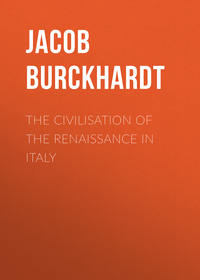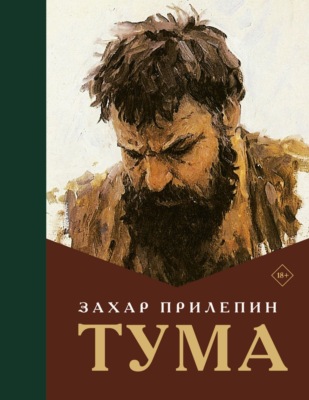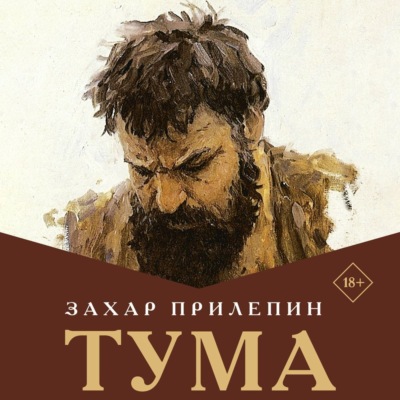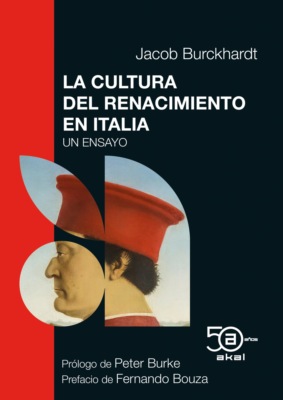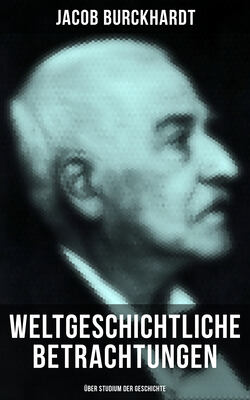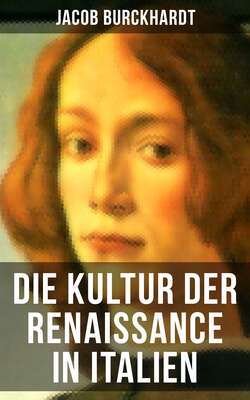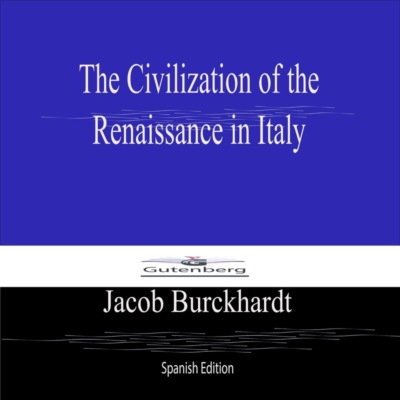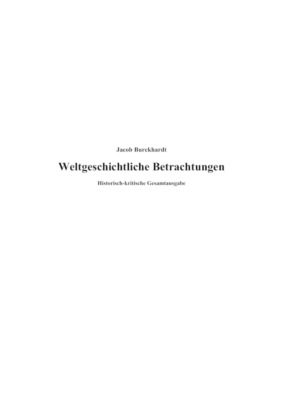Читать книгу: «The Civilisation of the Renaissance in Italy», страница 25
CHAPTER VI.
THE POSITION OF WOMEN
TO understand the higher forms of social intercourse at this period, we must keep before our minds the fact that women stood on a footing of perfect equality with men.891 We must not suffer ourselves to be misled by the sophistical and often malicious talk about the assumed inferiority of the female sex, which we meet with now and then in the dialogues of this time,892 nor by such satires as the third of Ariosto,893 who treats woman as a dangerous grown-up child, whom a man must learn how to manage, in spite of the great gulf between them. There is, indeed, a certain amount of truth in what he says. Just because the educated woman was on a level with the man, that communion of mind and heart which comes from the sense of mutual dependence and completion, could not be developed in marriage at this time, as it has been developed later in the cultivated society of the North.
The education given to women in the upper classes was essentially the same as that given to men. The Italian, at the time of the Renaissance, felt no scruple in putting sons and daughters alike under the same course of literary and even philological instruction (p. 222). Indeed, looking at this ancient culture as the chief treasure of life, he was glad that his girls should have a share in it. We have seen what perfection was attained by the daughters of princely houses in writing and speaking Latin (p. 234).894 Many others must at least have been able to read it, in order to follow the conversation of the day, which turned largely on classical subjects. An active interest was taken by many in Italian poetry, in which, whether prepared or improvised, a large number of Italian women, from the time of the Venetian Cassandra Fedele onwards (about the close of the fifteenth century), made themselves famous.895 One, indeed, Vittoria Colonna, may be called immortal. If any proof were needed of the assertion made above, it would be found in the manly tone of this poetry. Even the love-sonnets and religious poems are so precise and definite in their character, and so far removed from the tender twilight of sentiment, and from all the dilettantism which we commonly find in the poetry of women, that we should not hesitate to attribute them to male authors, if we had not clear external evidence to prove the contrary.
For, with education, the individuality of women in the upper classes was developed in the same way as that of men. Till the time of the Reformation, the personality of women out of Italy, even of the highest rank, comes forward but little. Exceptions like Isabella of Bavaria, Margaret of Anjou, and Isabella of Castille, are the forced result of very unusual circumstances. In Italy, throughout the whole of the fifteenth century, the wives of the rulers, and still more those of the Condottieri, have nearly all a distinct, recognisable personality, and take their share of notoriety and glory. To these came gradually to be added a crowd of famous women of the most varied kind (i. p. 147, note 1); among them those whose distinction consisted in the fact that their beauty, disposition, education, virtue, and piety, combined to render them harmonious human beings.896 There was no question of ‘woman’s rights’ or female emancipation, simply because the thing itself was a matter of course. The educated woman, no less than the man, strove naturally after a characteristic and complete individuality. The same intellectual and emotional development which perfected the man, was demanded for the perfection of the woman. Active literary work, nevertheless, was not expected from her, and if she were a poet, some powerful utterance of feeling, rather than the confidences of the novel or the diary, was looked for. These women had no thought of the public;897 their function was to influence distinguished men, and to moderate male impulse and caprice.
The highest praise which could then be given to the great Italian women was that they had the mind and the courage of men. We have only to observe the thoroughly manly bearing of most of the women in the heroic poems, especially those of Bojardo and Ariosto, to convince ourselves that we have before us the ideal of the time. The title ‘virago,’ which is an equivocal compliment in the present day, then implied nothing but praise. It was borne in all its glory by Caterina Sforza, wife and afterwards widow of Giroloma Riario, whose hereditary possession, Forli, she gallantly defended first against his murderers, and then against Cæsar Borgia. Though finally vanquished, she retained the admiration of her countrymen and the title ‘prima donna d’Italia.’898 This heroic vein can be detected in many of the women of the Renaissance, though none found the same opportunity of showing their heroism to the world. In Isabella Gonzaga this type is clearly recognisable, and not less in Clarice, of the House of Medici, the wife of Filippo Strozzi.899
Women of this stamp could listen to novels like those of Bandello, without social intercourse suffering from it. The ruling genius of society was not, as now, womanhood, or the respect for certain presuppositions, mysteries, and susceptibilities, but the consciousness of energy, of beauty, and of a social state full of danger and opportunity. And for this reason we find, side by side with the most measured and polished social forms, something our age would call immodesty,900 forgetting that by which it was corrected and counterbalanced—the powerful characters of the women who were exposed to it.
That in all the dialogues and treatises together we can find no absolute evidence on these points is only natural, however freely the nature of love and the position and capacities of women were discussed.
What seems to have been wanting in this society were the young girls,901 who, even when not brought up in the monasteries, were still carefully kept away from it. It is not easy to say whether their absence was the cause of the greater freedom of conversation, or whether they were removed on account of it.
Even the intercourse with courtesans seems to have assumed a more elevated character, reminding us of the position of the Hetairae in Classical Athens. The famous Roman courtesan Imperia was a woman of intelligence and culture, had learned from a certain Domenico Campana the art of making sonnets, and was not without musical accomplishments.902 The beautiful Isabella de Luna, of Spanish extraction, who was reckoned amusing company, seems to have been an odd compound of a kind heart with a shockingly foul tongue, which latter sometimes brought her into trouble.903 At Milan, Bandello knew the majestic Caterina di San Celso,904 who played and sang and recited superbly. It is clear from all we read on the subject that the distinguished people who visited these women, and from time to time lived with them, demanded from them a considerable degree of intelligence and instruction, and that the famous courtesans were treated with no slight respect and consideration. Even when relations with them were broken off, their good opinion was still desired,905 which shows that departed passion had left permanent traces behind. But on the whole this intellectual intercourse is not worth mentioning by the side of that sanctioned by the recognised forms of social life, and the traces which it has left in poetry and literature are for the most part of a scandalous nature. We may well be astonished that among the 6,800 persons of this class, who were to be found in Rome in 1490906—that is, before the appearance of syphilis—scarcely a single woman seems to have been remarkable for any higher gifts. These whom we have mentioned all belong to the period which immediately followed. The mode of life, the morals and the philosophy of the public women, who with all their sensuality and greed were not always incapable of deeper passions, as well as the hypocrisy and devilish malice shown by some in their later years, are best set forth by Giraldi, in the novels which form the introduction to the ‘Hecatommithi.’ Pietro Aretino, in his ‘Ragionamenti,’ gives us rather a picture of his own depraved character than of this unhappy class of women as they really were.
The mistresses of the princes, as has already been pointed out (p. 53), were sung by poets and painted by artists, and in consequence have been personally familiar to their contemporaries and to posterity. We hardly know more than the name of Alice Perrers and of Clara Dettin, the mistress of Frederick the Victorious, and of Agnes Sorel have only a half-legendary story. With the monarchs of the age of the Renaissance—Francis I. and Henry II.—the case is different.
CHAPTER VII.
DOMESTIC ECONOMY
AFTER treating of the intercourse of society, let us glance for a moment at the domestic life of this period. We are commonly disposed to look on the family life of the Italians at this time as hopelessly ruined by the national immorality, and this side of the question will be more fully discussed in the sequel. For the moment we must content ourselves with pointing out that conjugal infidelity has by no means so disastrous an influence on family life in Italy as in the North, so long at least as certain limits are not overstepped.
The domestic life of the Middle Ages was a product of popular morals, or if we prefer to put it otherwise, a result of the inborn tendencies of national life, modified by the varied circumstances which affected them. Chivalry at the time of its splendour left domestic economy untouched. The knight wandered from court to court, and from one battle-field to another. His homage was given systematically to some other woman than his own wife, and things went how they might at home in the castle.907 The spirit of the Renaissance first brought order into domestic life, treating it as a work of deliberate contrivance. Intelligent economical views (p. 77), and a rational style of domestic architecture served to promote this end. But the chief cause of the change was the thoughtful study of all questions relating to social intercourse, to education, to domestic service and organisation.
The most precious document on this subject is the treatise on the management of the home by Agnolo Pandolfini (L. B. Alberti).908 He represents a father speaking to his grown-up sons, and initiating them into his method of administration. We are introduced into a large and wealthy household, which if governed with moderation and reasonable economy, promises happiness and prosperity for generations to come. A considerable landed estate, whose produce furnishes the table of the house, and serves as the basis of the family fortune, is combined with some industrial pursuit, such as the weaving of wool or silk. The dwelling is solid and the food good. All that has to do with the plan and arrangement of the house is great, durable, and costly, but the daily life within it is as simple as possible. All other expenses, from the largest in which the family honour is at stake, down to the pocket-money of the younger sons, stand to one another in a rational, not a conventional relation. Nothing is considered of so much importance as education, which the head of the house gives not only to the children, but to the whole household. He first develops his wife from a shy girl, brought up in careful seclusion, to the true woman of the house, capable of commanding and guiding the servants. The sons are brought up without any undue severity,909 carefully watched and counselled, and controlled ‘rather by authority than by force.’ And finally the servants are chosen and treated on such principles that they gladly and faithfully hold by the family.
One feature of this book must be referred to, which is by no means peculiar to it, but which it treats with special warmth—the love of the educated Italian for country life.910 In northern countries the nobles lived in the country in their castles, and the monks of the higher orders in their well-guarded monasteries, while the wealthiest burghers dwelt from one year’s end to another in the cities. But in Italy, so far as the neighbourhood of certain towns at all events was concerned,911 the security of life and property was so great, and the passion for a country residence was so strong, that men were willing to risk a loss in time of war. Thus arose the villa, the country-house of the well-to-do citizen. This precious inheritance of the old Roman world was thus revived, as soon as the wealth and culture of the people were sufficiently advanced.
One author finds at his villa a peace and happiness, for an account of which the reader must hear him speak himself: ‘While every other possession causes work and danger, fear and disappointment, the villa brings a great and honourable advantage; the villa is always true and kind; if you dwell in it at the right time and with love, it will not only satisfy you, but add reward to reward. In spring the green trees and the song of the birds will make you joyful and hopeful; in autumn a moderate exertion will bring forth fruit a hundredfold; all through the year melancholy will be banished from you. The villa is the spot where good and honest men love to congregate. Nothing secret, nothing treacherous, is done here; all see all; here is no need of judges or witnesses, for all are kindly and peaceably disposed one to another. Hasten hither, and fly away from the pride of the rich, and the dishonour of the bad. O blessed life in the villa, O unknown fortune!’ The economical side of the matter is that one and the same property must, if possible, contain everything—corn, wine, oil, pasture-land and woods, and that in such cases the property was paid for well, since nothing needed then to be got from the market. But the higher enjoyment derived from the villa is shown by some words of the introduction: ‘Round about Florence lie many villas in a transparent atmosphere, amid cheerful scenery, and with a splendid view; there is little fog, and no injurious winds; all is good, and the water pure and healthy. Of the numerous buildings many are like palaces, many like castles, costly and beautiful to behold.’ He is speaking of those unrivalled villas, of which the greater number were sacrificed, though vainly, by the Florentines themselves in the defence of their city in the year 1529.912
In these villas, as in those on the Brenta, on the Lombard hills, at Posilippo and on the Vomero, social life assumed a freer and more rural character than in the palaces within the city. We meet with charming descriptions of the intercourse of the guests, the hunting-parties, and all the open-air pursuits and amusements.913 But the noblest achievements of poetry and thought are sometimes also dated from these scenes of rural peace.
CHAPTER VIII.
THE FESTIVALS
IT is by no arbitrary choice that in discussing the social life of this period, we are led to treat of the processions and shows which formed part of the popular festivals.914 The artistic power of which the Italians of the Renaissance gave proof on such occasions,915 was attained only by means of that free intercourse of all classes which formed the basis of Italian society. In Northern Europe the monasteries, the courts, and the burghers had their special feasts and shows as in Italy; but in the one case the form and substance of these displays differed according to the class which took part in them, in the other an art and culture common to the whole nation stamped them with both a higher and a more popular character. The decorative architecture, which served to aid in these festivals, deserves a chapter to itself in the history of art, although our imagination can only form a picture of it from the descriptions which have been left to us. We are here more especially concerned with the festival as a higher phase in the life of the people, in which its religious, moral, and poetical ideas took visible shape. The Italian festivals in their best form mark the point of transition from real life into the world of art.
The two chief forms of festal display were originally here, as elsewhere in the West, the Mystery, or the dramatisation of sacred history and legend, and the Procession, the motive and character of which was also purely ecclesiastical.
The performances of the Mysteries in Italy were from the first more frequent and splendid than elsewhere, and were most favourably affected by the progress of poetry and of the other arts. In the course of time not only did the farce and the secular drama branch off from the Mystery, as in other countries of Europe, but the pantomime also, with its accompaniments of singing and dancing, the effect of which depended on the richness and beauty of the spectacle.
The Procession, in the broad, level, and well-paved streets of the Italian cities,916 was soon developed into the ‘Trionfo,’ or train of masked figures on foot and in chariots, the ecclesiastical character of which gradually gave way to the secular. The processions at the Carnival and at the feast of Corpus Christi917 were alike in the pomp and brilliancy with which they were conducted, and set the pattern afterwards followed by the royal or princely progresses. Other nations were willing to spend vast sums of money on these shows, but in Italy alone do we find an artistic method of treatment which arranged the procession as a harmonious and significative whole.
What is left of these festivals is but a poor remnant of what once existed. Both religious and secular displays of this kind have abandoned the dramatic element—the costumes—partly from dread of ridicule, and partly because the cultivated classes, who formerly gave their whole energies to these things, have for several reasons lost their interest in them. Even at the Carnival, the great processions of masks are out of fashion. What still remains, such as the costumes adopted in imitation of certain religious confraternities, or even the brilliant festival of Santa Rosalia at Palermo, shows clearly how far the higher culture of the country has withdrawn from such interests.
The festivals did not reach their full development till after the decisive victory of the modern spirit in the fifteenth century,918 unless perhaps Florence was here, as in other things, in advance of the rest of Italy. In Florence, the several quarters of the city were, in early times, organized with a view to such exhibitions, which demanded no small expenditure of artistic effort. Of this kind was the representation of Hell, with a scaffold and boats in the Arno, on the 1st of May, 1304, when the Ponte alla Carraja broke down under the weight of the spectators.919 That at a later time Florentines used to travel through Italy as directors of festivals (festaiuoli), shows that the art was early perfected at home.920
In setting forth the chief points of superiority in the Italian festivals over those of other countries, the first that we shall have to remark is the developed sense of individual characteristics, in other words, the capacity to invent a given mask, and to act the part with dramatic propriety. Painters and sculptors not merely did their part towards the decoration of the place where the festival was held, but helped in getting up the characters themselves, and prescribed the dress, the paints (p. 373), and the other ornaments to be used. The second fact to be pointed out is the universal familiarity of the people with the poetical basis of the show. The Mysteries, indeed, were equally well understood all over Europe, since the biblical story and the legends of the saints were the common property of Christendom; but in all other respects the advantage was on the side of Italy. For the recitations, whether of religious or secular heroes, she possessed a lyrical poetry so rich and harmonious that none could resist its charm.921 The majority, too, of the spectators—at least in the cities—understood the meaning of mythological figures, and could guess without much difficulty at the allegorical and historical, which were drawn from sources familiar to the mass of Italians.
This point needs to be more fully discussed. The Middle Ages were essentially the ages of allegory. Theology and philosophy treated their categories as independent beings,922 and poetry and art had but little to add, in order to give them personality. Here all the countries of the West were on the same level. Their world of ideas was rich enough in types and figures, but when these were put into concrete shape, the costume and attributes were likely to be unintelligible and unsuited to the popular taste. This, even in Italy, was often the case, and not only so during the whole period of the Renaissance, but down to a still later time. To produce the confusion, it was enough if a predicate of the allegorical figures was wrongly translated by an attribute. Even Dante is not wholly free from such errors,923 and, indeed, he prides himself on the obscurity of his allegories in general.924 Petrarch, in his ‘Trionfi,’ attempts to give clear, if short, descriptions of at all events the figures of Love, of Chastity, of Death, and of Fame. Others again load their allegories with inappropriate attributes. In the Satires of Vinciguerra,925 for example, Envy is depicted with rough, iron teeth, Gluttony as biting its own lips, and with a shock of tangled hair, the latter probably to show its indifference to all that is not meat and drink. We cannot here discuss the bad influence of these misunderstandings on the plastic arts. They, like poetry, might think themselves fortunate if allegory could be expressed by a mythological figure—by a figure which antiquity saved from absurdity—if Mars might stand for war, and Diana926 for the love of the chase.
Nevertheless art and poetry had better allegories than these to offer, and we may assume with regard to such figures of this kind as appeared in the Italian festivals, that the public required them to be clearly and vividly characteristic, since its previous training had fitted it to be a competent critic. Elsewhere, particularly at the Burgundian court, the most inexpressive figures, and even mere symbols, were allowed to pass, since to understand, or to seem to understand them, was a part of aristocratic breeding. On the occasion of the famous ‘Oath of the Pheasant’ in the year 1453,927 the beautiful young horsewoman, who appears as ‘Queen of Pleasure,’ is the only pleasing allegory. The huge dishes, with automatic or even living figures within them, are either mere curiosities or are intended to convey some clumsy moral lesson. A naked female statue guarding a live lion was supposed to represent Constantinople and its future saviour, the Duke of Burgundy. The rest, with the exception of a Pantomime—Jason in Colchis—seems either too recondite to be understood or to have no sense at all. Olivier himself, to whom we owe the description of the scene, appeared costumed as ‘The Church,’ in a tower on the back of an elephant, and sang a long elegy on the victory of the unbelievers.928
But although the allegorical element in the poetry, the art, and the festivals of Italy is superior both in good taste and in unity of conception to what we find in other countries, yet it is not in these qualities that it is most characteristic and unique. The decisive point of superiority929 lay rather in the fact, that besides the personifications of abstract qualities, historical representatives of them were introduced in great number—that both poetry and plastic art were accustomed to represent famous men and women. The ‘Divine Comedy,’ the ‘Trionfi’ of Petrarch, the ‘Amorosa Visione’ of Boccaccio—all of them works constructed on this principle—and the great diffusion of culture which took place under the influence of antiquity, had made the nation familiar with this historical element. These figures now appeared at festivals, either individualised, as definite masks, or in groups, as characteristic attendants on some leading allegorical figure. The art of grouping and composition was thus learnt in Italy at a time when the most splendid exhibitions in other countries were made up of unintelligible symbolism or unmeaning puerilities.
Let us begin with that kind of festival which is perhaps the oldest of all—the Mysteries.930 They resembled in their main features those performed in the rest of Europe. In the public squares, in the churches, and in the cloisters extensive scaffolds were constructed, the upper story of which served as a Paradise to open and shut at will, and the ground-floor often as a Hell, while between the two lay the stage properly so called, representing the scene of all the earthly events of the drama. In Italy, as elsewhere, the biblical or legendary play often began with an introductory dialogue between Apostles, Prophets, Sibyls, Virtues, and Fathers of the Church, and sometimes ended with a dance. As a matter of course the half-comic ‘Intermezzi’ of secondary characters were not wanting in Italy, yet this feature was hardly so broadly marked as in northern countries.931 The artificial means by which figures were made to rise and float in the air—one of the chief delights of these representations—were probably much better understood in Italy than elsewhere; and at Florence in the fourteenth century the hitches in these performances were a stock subject of ridicule.932 Soon after Brunellesco invented for the Feast of the Annunciation in the Piazza San Felice a marvellous apparatus consisting of a heavenly globe surrounded by two circles of angels, out of which Gabriel flew down in a machine shaped like an almond. Cecca, too, devised the mechanism for such displays.933 The spiritual corporations or the quarters of the city which undertook the charge and in part the performance of these plays spared, at all events in the larger towns, no trouble and expense to render them as perfect and artistic as possible. The same was no doubt the case at the great court festivals, when Mysteries were acted as well as pantomimes and secular dramas. The court of Pietro Riario (p. 106), and that of Ferrara were assuredly not wanting in all that human invention could produce.934 When we picture to ourselves the theatrical talent and the splendid costumes of the actors, the scenes constructed in the style of the architecture of the period, and hung with garlands and tapestry, and in the background the noble buildings of an Italian piazza, or the slender columns of some great courtyard or cloister, the effect is one of great brilliance. But just as the secular drama suffered from this passion for display, so the higher poetical development of the Mystery was arrested by the same cause. In the texts which are left we find for the most part the poorest dramatic groundwork, relieved now and then by a fine lyrical or rhetorical passage, but no trace of the grand symbolic enthusiasm which distinguishes the ‘Autos Sagramentales’ of Calderon.
In the smaller towns, where the scenic display was less, the effect of these spiritual plays on the character of the spectators may have been greater. We read935 that one of the great preachers of repentance of whom more will be said later on, Roberto da Lecce, closed his Lenten sermons during the plague of 1448, at Perugia, with a representation of the Passion. The piece followed the New Testament closely. The actors were few, but the whole people wept aloud. It is true that on such occasions emotional stimulants were resorted to which were borrowed from the crudest realism. We are reminded of the pictures of Matteo da Siena, or of the groups of clay-figures by Guido Mazzoni, when we read that the actor who took the part of Christ appeared covered with wales and apparently sweating blood, and even bleeding from a wound in the side.936
The special occasions on which these mysteries were performed, apart from the great festivals of the Church, from princely weddings, and the like, were of various kinds. When, for example, S. Bernardino of Siena was canonised by the Pope (1450), a sort of dramatic imitation of the ceremony took place (rappresentazione), probably on the great square of his native city, and for two days there was feasting with meat and drink for all comers.937 We are told that a learned monk celebrated his promotion to the degree of Doctor of Theology, by giving a representation of the legend about the patron saint of the city.938 Charles VIII. had scarcely entered Italy before he was welcomed at Turin by the widowed Duchess Bianca of Savoy with a sort of half-religious pantomime,939 in which a pastoral scene first symbolised the Law of Nature, and then a procession of patriarchs the Law of Grace. Afterwards followed the story of Lancelot of the Lake, and that ‘of Athens.’ And no sooner had the King reached Chieri, than he was received with another pantomime, in which a woman in childbed was shown, surrounded by distinguished visitors.
If any church festival was held by universal consent to call for exceptional efforts, it was the feast of Corpus Christi, which in Spain (p. 413) gave rise to a special class of poetry. We possess a splendid description of the manner in which that feast was celebrated at Viterbo by Pius II. in 1482.940 The procession itself, which advanced from a vast and gorgeous tent in front of S. Francesco along the main street to the Cathedral, was the least part of the ceremony. The cardinals and wealthy prelates had divided the whole distance into parts, over which they severally presided, and which they decorated with curtains, tapestry, and garlands.941 Each of them had also erected a stage of his own, on which, as the procession passed by, short historical and allegorical scenes were represented. It is not clear from the account whether all the characters were living beings or some merely draped figures;942 the expense was certainly very great. There was a suffering Christ amid singing cherubs, the Last Supper with a figure of St. Thomas Aquinas, the combat between the Archangel Michael and the devils, fountains of wine and orchestras of angels, the grave of Christ with all the scene of the Resurrection, and finally, on the square before the Cathedral, the tomb of the Virgin. It opened after High Mass and the benediction, and the Mother of God ascended singing to Paradise, where she was crowned by her Son, and led into the presence of the Eternal Father.
‘Tu verbera misceTergaque nunc duro resonent pulsata bacillo.’ Italian writers on the woman’s side are Benedetto da Cesena, De Honore Mulierum, Venice, 1500, Dardano, La defesa della Donna, Ven. 1554, Per Donne Romane. ed. Manfredi, Bol. 1575. The defence of, or attack on, women, supported by instances of famous or infamous women down to the time of the writer, was also treated by the Jews, partly in Italian and partly in Hebrew; and in connection with an earlier Jewish literature dating from the thirteenth century, we may mention Abr. Sarteano and Eliah Gennazzano, the latter of whom defended the former against the attacks of Abigdor (for their MS. poems about year 1500, comp. Steinschneider, Hebr. Bibliogr. vi. 48).
‘Annaque Theutonico tibi si dabit obvia cantu.’
In Italy beating ceased early; Maffeo Vegio (d. 1458) recommends (De Educ. Liber. lib. i. c. 19) moderation in flogging, but adds: ‘Caedendos magis esse filios quam pestilentissmis blanditiis laetandos.’ At a later time a child of seven was no longer beaten. The little Roland (Orlandino, cap. vii. str. 42) lays down the principle:
‘Sol gli asini si ponno bastonare,Se una tal bestia fussi, patirei.’ The German humanists of the Renaissance, like Rudolf Agricola and Erasmus, speak decisively against flogging, which the elder schoolmasters regarded as an indispensable means of education. In the biographies of the Fahrenden Schüler at the close of the fifteenth century (Platter’s Lebensbeschriebung, ed. Fechter, Basel, 1840; Butzbach’s Wanderbuch, ed. Becher, Regensburg, 1869) there are gross examples of the corporal punishment of the time.
Покупайте книги и получайте бонусы в Литрес, Читай-городе и Буквоеде.
Участвовать в бонусной программе
